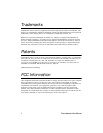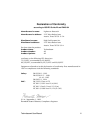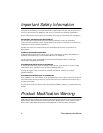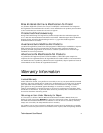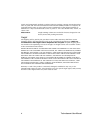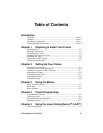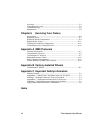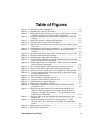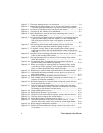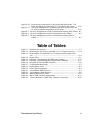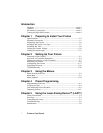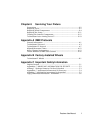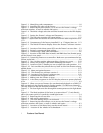x Technobeam
®
User Manual
Figure 5-5. The laser aiming device circuit board. ........................................ 5-8
Figure 6-1. Removing the door allows you to access the fixture’s voltage
selection switches and fuses, as well as wheels and optics. .... 6-3
Figure 6-2. Locations of the three fuses on the circuit board........................ 6-4
Figure 6-3. Location of the wheels in Technobeam. ..................................... 6-5
Figure 6-4. Push the dichroic toward the large retaining tab to free it
from the wheel tabs.................................................................. 6-6
Figure 6-5. You can easily tell which side of a dichroic is coated by placing
a pen or other object near the surface; on the coated side,
the reflection from the object will appear to touch the
object........................................................................................ 6-6
Figure 6-6. The rotating litho wheel and rotating effects wheel have
built-in plastic tabs that hold the spring in place. ................... 6-7
Figure 6-7. To replace a static litho in the rotating litho wheel, gently
separate the wheel and reach behind the wheel to push the
litho out. ................................................................................... 6-8
Figure 6-8. Location of the retaining tabs and slot that secure the static
litho in the rotating litho wheel. .............................................. 6-9
Figure 6-9. The gap between the two halves of the rotating litho wheel
must be uniform....................................................................... 6-9
Figure 6-10. An aperture ring, if required, must be placed on top of
the litho/effect and under the spring.................................... 6-10
Figure 6-11. When you replace a rotating litho or rotating effect, make
sure the tip of the spring is fully seated under the wheel
tabs; it cannot protrude from under the tabs........................ 6-10
Figure 6-12. Replacing a custom multi-colored litho in the metal holder.. 6-11
Figure 6-13. Loosening the lamp assembly screws gives you access to
the fixture lamp..................................................................... 6-12
Figure 6-14. Removing the lamp assembly from the fixture. ..................... 6-12
Figure 6-15. Pull straight up on the lamp, grasping its ceramic base, to
remove it from the assembly................................................. 6-13
Figure 6-16. Hold the lamp by its ceramic base and gently press the two
base pins into the socket....................................................... 6-13
Figure 6-17. You can look at the lamp label text to make sure the lamp
plate is oriented correctly; incorrect orientation can result
in damage to the fixture and the lamp.................................. 6-14
Figure 6-18. Lamp optimization screws...................................................... 6-15
Figure 6-19. Opening the fixture’s access door. ......................................... 6-16
Figure 6-20. Location of the anti-reflective glass, lenses and hot mirror... 6-17
Figure 6-21. The lens tube contains the zoom lenses. ............................... 6-17
Figure 6-22. Clean both sides of the hot mirror glass. ............................... 6-18
Figure 6-23. The ideal position of the laser is no more than 2” (5 cm)
directly above the center of a perfectly round light beam.... 6-19
Figure 6-24. High-voltage component location........................................... 6-20
Figure 6-25. Orient the fixture directly facing a wall no less than 10 ft.
(3 m) away.............................................................................. 6-21



